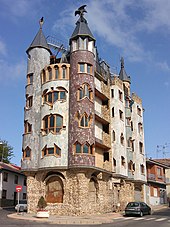Valencia de Don Juan
| Valencia de Don Juan municipality | ||
|---|---|---|
 Valencia de Don Juan - Castle (castillo)
|
||
| coat of arms | Map of Spain | |

|
|
|
| Basic data | ||
| Autonomous Community : | Castile and Leon | |
| Province : | Leon | |
| Coordinates | 42 ° 18 ′ N , 5 ° 31 ′ W | |
| Height : | 768 msnm | |
| Area : | 58.5 km² | |
| Residents : | 5,351 (Jan 1, 2019) | |
| Population density : | 91.47 inhabitants / km² | |
| Postal code : | 24200 | |
| Municipality number ( INE ): | 24188 | |
| administration | ||
| Website : | Valencia de Don Juan | |
Valencia de Don Juan (formerly Valencia de Campos ) is a small town and a northern Spanish municipality with 5,351 inhabitants (as of January 1, 2019) in the province of León and the region of Castile-León . The city is located on a branch of the Camino de Santiago that comes from the south ( Seville , Mérida , Cáceres , Salamanca and Zamora ) and joins the main route in León or Astorga .
Location and climate
The small town of Valencia de Don Juan is located on the east bank of the Río Esla in the northwest of the Iberian Meseta approx. 40 km (driving distance) south of the city of León at an altitude of approx. 770 m ; the cities of Sahagún and Astorga on the Way of St. James are only about 48 km northeast and 54 km northwest, respectively. The climate in winter is harsh, but in summer it is dry and warm; the sparse rain (approx. 480 mm / year) falls mainly in the winter half-year.
Population development
| year | 1857 | 1900 | 1950 | 2000 | 2017 |
| Residents | 1,862 | 2,344 | 4.127 | 4.064 | 5,201 |
Because by the mechanization of agriculture triggered and the abandonment of small farms rural exodus , the population of the town has grown steadily since the mid-19th century.
economy
The small town is on an old trade route in the northwest of the Iberian Peninsula . The area around Valencia de Don Juan was and is essentially agricultural; for centuries people lived largely on a self-sufficient basis . It was only through the improvement of the infrastructure in the 20th century that it was possible to produce for the market. The city itself serves as a craft and mercantile center for the surrounding villages. Day tourism has been of greater importance since the 1960s.
history
The oldest known name of the place is Coyanza (see city arms); until the end of the 14th century his name was Valencia de Campos . It was a rule that was owned by the royal family. The first landlord (señor) of the place and its surrounding area is attested to the Infanta John of Castile (sometimes also referred to as Juan de Haro ), a son of King Alfonso X , who fell on June 25, 1319 off Granada . In 1379, Valencia de Campos was raised to a duchy for John of Portugal (1349-1397); he was the client of the Castillo de Valencia de Don Juan , but he did not see its completion himself. John of Portugal was the son of King Pedro and Inês de Castro , who appeared as a pretender to the throne after the death of King Ferdinand I , his half-brother, although he was legitimized but excluded from the line of succession, and finally to another half-brother, the illegitimate one Johann von Aviz , had to give way. His daughter and heiress held the title of Countess of Valencia, which has been called Valencia de Don Juan since then. For Juan de Acuña y Portugal, the 3rd Count of Valencia de Don Juan, the duchy was renewed in 1465.
Attractions
- The Castillo de Valencia de Don Juan , possibly built on the site of an Iron Age , later Roman fortress, was one of the most monumental and imposing castles of the late Middle Ages. The city-side front has been rebuilt in several sections since the 1950s, while the rear, river-side part is still in ruins. A museum on the city's history is housed in the restored rooms.
- The classical Iglesia de San Pedro Apóstol is located in the central square right next to the town hall. The strict, two-tower building with presented columns dates from the 19th century (completed in 1876). In the apse is an approx. 13 m high and 9 m wide carved altar by the master Guillén Doncel, largely unknown even in Spain, with scenes of the Passion of Christ from the 16th century. The late Gothic Madonna of the Virgen del Castillo Viejo comes from the old castle church and is the patron saint of the city.
- The Edificio Centinela is an idiosyncratic five-storey new residential building with echoes of Antoni Gaudí's style . Santiago Nava, the owner and builder, has been working on the still unfinished building since 1990.
Web links
Individual evidence
- ↑ Cifras oficiales de población resultantes de la revisión del Padrón municipal a 1 de enero . Population statistics from the Instituto Nacional de Estadística (population update).
- ↑ Valencia de Don Juan - climate tables
- ↑ Valencia de Don Juan - population development
- ↑ Valencia de Don Juan - History and Sights
- ↑ Guillén Doncel - biography and work
- ↑ Valencia de Don Juan - Church of San Pedro Apóstol
- ↑ Valencia de Don Juan - Church of San Pedro Apóstol
- ↑ Valencia de Don Juan - Edificio Centinela




